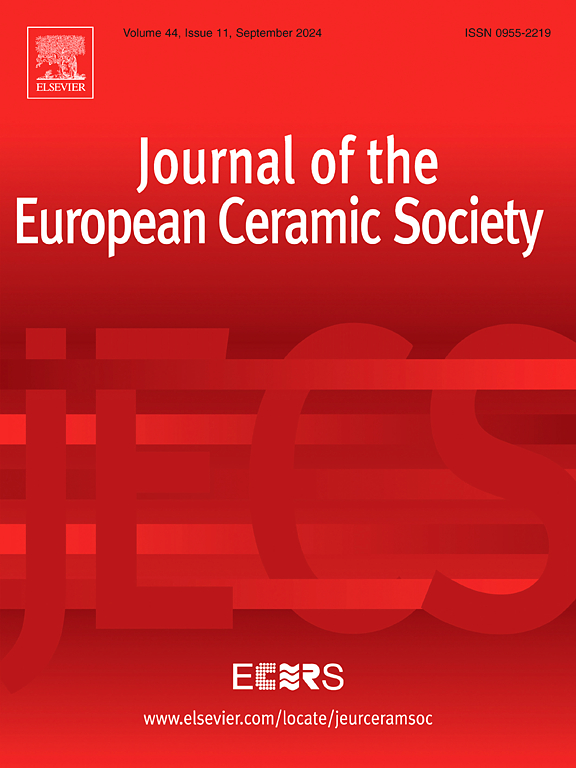Formation and mechanism of carbon coating on carbon fibers through glucose-to-carbon conversion and its effect on the mechanical properties of Cf/ZrB2-SiC composites
IF 5.8
2区 材料科学
Q1 MATERIALS SCIENCE, CERAMICS
Journal of The European Ceramic Society
Pub Date : 2025-05-29
DOI:10.1016/j.jeurceramsoc.2025.117569
引用次数: 0
Abstract
The protection for carbon fibers is crucial for carbon fiber-reinforced materials. Carbon coatings were prepared on carbon fibers through gelation, hydrothermal caramelization and pyrolysis, with glucose as precursor of carbon. The glucose-to-carbon conversion mechanism was explored, as well as the effect of high pressure in hydrothermal reactor and the catalytic role of KCl. The high pressure suppressed gas escape and was beneficial to the formation of dense carbon coating. The KCl promoted the generation of 5-HMF, thereby accelerated the glucose-to-caramel conversion. Cf/ZrB2-SiC composites were prepared by introducing ZrB2-SiC slurry into the carbon fiber preform and hot press sintering. The carbon coating protected the carbon fibers from damage during sintering at high temperature. The carbon coating significantly improved the flexural strength, fracture toughness, and fracture work of Cf/ZrB2-SiC composites from 122 MPa, 3.24 MPa‧m1/2, and 231.6 J/m2 to 321 MPa, 5.87 MPa‧m1/2, and 567.1 J/m2, respectively.
葡萄糖-碳转化炭膜在碳纤维上的形成、机理及其对Cf/ZrB2-SiC复合材料力学性能的影响
对碳纤维的保护是碳纤维增强材料的关键。以葡萄糖为碳的前驱体,通过凝胶、水热焦糖化和热解在碳纤维上制备碳涂层。探讨了葡萄糖转化为碳的机理,以及水热反应器中高压的影响和KCl的催化作用。高压抑制了气体逸出,有利于致密碳涂层的形成。KCl促进了5-HMF的生成,从而加速了葡萄糖到焦糖的转化。将ZrB2-SiC浆料引入碳纤维预制体中,通过热压烧结制备Cf/ZrB2-SiC复合材料。碳涂层保护碳纤维在高温烧结过程中不受破坏。碳涂层使Cf/ZrB2-SiC复合材料的抗弯强度、断裂韧性和断裂功分别从122 MPa、3.24 MPa·m1/2和231.6 J/m2显著提高到321 MPa、5.87 MPa·m1/2和567.1 J/m2。
本文章由计算机程序翻译,如有差异,请以英文原文为准。
求助全文
约1分钟内获得全文
求助全文
来源期刊

Journal of The European Ceramic Society
工程技术-材料科学:硅酸盐
CiteScore
10.70
自引率
12.30%
发文量
863
审稿时长
35 days
期刊介绍:
The Journal of the European Ceramic Society publishes the results of original research and reviews relating to ceramic materials. Papers of either an experimental or theoretical character will be welcomed on a fully international basis. The emphasis is on novel generic science concerning the relationships between processing, microstructure and properties of polycrystalline ceramics consolidated at high temperature. Papers may relate to any of the conventional categories of ceramic: structural, functional, traditional or composite. The central objective is to sustain a high standard of research quality by means of appropriate reviewing procedures.
 求助内容:
求助内容: 应助结果提醒方式:
应助结果提醒方式:


